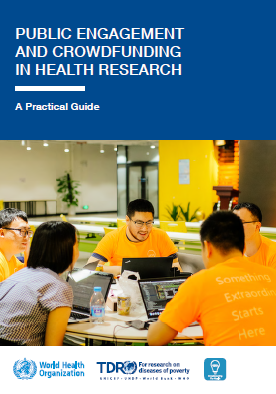TDR/Regional Office-funded research in scientific press (2000–2010)
References
Brucellosis
- El Sherbini A et al. Risk factors and diagnostic criteria of brucellosis in an endemic area in Egypt. Infectious diseases in clinical practice, 2005, 13(6):295–9.
- Kattar M et al. Development and evaluation of real-time polymerase chain reaction assays on whole blood and paraffin-embedded tissues for rapid diagnosis of human brucellosis. Diagnostic microbiology and infectious disease, 2007, 59:23–32. |PubMed|
- El Sherbini A et al. Seroprevalences and local variation of human and livestock brucellosis in two villages in Gharbia Governorate, Egypt. Transactions of the Royal Society of Tropical Medicine and Hygiene, 2007, 101: 923–928. |PubMed|
Crimean-Congo haemorrhagic fever
- Naeieni KH, et al. Seroprevalence, incidence and risk factors of Crimean-Congo hemorrhagic fever in Sistan-va-Baluchistan province, Iran. Iranian journal of public health, 2004, 33(4):1–7.
Human immunodeficiency virus (HIV) and sexually transmitted infections
- Kabbash I et al. Pattern of condom use among males in lower Egypt. Eastern Mediterranean health journal, 2007, 6:1405–1416. |PubMed|
- Kabbash I et al. Evaluation of risk perception and precautions taken by health care workers for HIV infection in hemodialysis units. Eastern Mediterranean health journal, 2007,13:392–407. |PubMed|
Leishmaniasis
- Jawabreh AO. Risk assessment of cutaneous leishmaniasis in Jericho city during the period 1994–1999. Islah Charitable Social Committee, Jericho, Palestine Ministry of Health, 2001.
- Yaghoobi-Ershadi MR, et al. Epidemiological study in a new focus of cutaneous leishmaniosis due to Leishmania major in Ardestan town, central Iran. Acta tropica, 2001, 79(2):115–21. |PubMed|
- Musa AM, et al. The natural history of Sudanese post-kala-azar dermal leishmaniasis: clinical, immunological and prognostic features. Annals of tropical medicine and parasitology, 2002, 96(8):765–72. |PubMed|
- Gavgani AS, et al. Effect of insecticide-impregnated dog collars on incidence of zoonotic visceral leishmaniasis in Iranian children: a matched-cluster randomised trial. Lancet, 2002, 360(9330):374–9. |PubMed|
- Gavgani AS et al. Domestic dog ownership in Iran is a risk factor for human infection with Leishmania infantum. The American journal of tropical medicine and hygiene, 2002, 67(5):511–15. |PubMed|
- Yaghoobi-Ershadi MR, et al. A new focus of cutaneous leishmaniasis caused by Leishmania tropica. Saudi medical journal, 2002, 23(3):291–4. |PubMed|
- Yaghoobi-Ershadi MR, et al. Epidemiological study in a new focus of cutaneous leishmaniasis in the Islamic Republic of Iran. Eastern Mediterranean health journal, 2003, 9(4):816–26. |PubMed|
- Elnaiem DE, et al. Risk mapping of visceral leishmaniasis: the role of local variation in rainfall and altitude on the presence and incidence of kala-azar in eastern Sudan. The American journal of tropical medicine and hygiene, 2003, 68(1):107. |PubMed|
- Islamic Republic of Iran. Eastern Mediterranean health journal, 2003, 9(4):816–26. |PubMed|
- Elnaiem D-EA, et al. Factors affecting variations in exposure to infections by Leishmania donovani in eastern Sudan. Eastern Mediterranean health journal, 2003, 9(4):827–36. |PubMed|
- El-Safi SH, et al. Field evaluation of latex agglutination test for detecting urinary antigens in visceral leishmaniasis in Sudan. Eastern Mediterranean health journal, 2003, 9(4):844–55. |PubMed|
- Al-Nahhas S, et al.. Visceral leishmaniasis in the Syrian Arab Republic: early detection using rK39. Eastern Mediterranean health journal, 2003, 9(4):856–62. |PubMed|
- Al-Jawabreh A, et al. Epidemiology of cutaneous leishmaniasis in the endemic area of Jericho, Palestine. Eastern Mediterranean health journal, 2003, 9(4):805–815. |PubMed|
- Abdo MG, et al. Antimony-resistant Leishmania donovani in eastern Sudan: incidence and in vitro correlation. Eastern Mediterranean health journal, 2003, 9(4):837–43. |PubMed|
- Kazemi B, et al. Immunization of Balb/C mice by protein fragments of lizard Leishmania promastigote. Pakistan journal of biological sciences, 2004, 7(10): 1699–709.
- Kazemi B, et al. Fractionation of lizard Leishmania promastigote protein. Pakistan journal of biological sciences, 2004, 7(10):1703–5.
- Firooz A et al. Imiquimod in combination with meglumine antimoniate for acute cutaneous leishmaniasis: A randomized assessor-blind controlled trial. Archives of dermatology, 2006, 142:1575-9. |PubMed|
- Sadeghian G, Nilfroushzadeh MA, Iraji F. Efficacy of local heat therapy by radiofrequency in the treatment of cutaneous leishmaniasis, compared with intralesional injection of meglumine antimoniate. Clinical and experimental dermatology, 2007, 32, 371–374. |PubMed|
Lymphatic filariasis
- Farid HA, et al. Filariasis elimination in Egypt: impact of low microfilaraemics as sources of infection for mosquitoes. Eastern Mediterranean health journal, 2003, 9(4):863–72. |PubMed|
Malaria
- Yousif MA, Adeel AA. Antimalarials prescribing patterns in Gezira State: percepts and practices. Eastern Mediterranean health journal, 2000, 6(5–6):939–47. |PubMed|
- Bassiouny HK. Bioenvironmental and meteorological factors related to the persistence of malaria in Fayoum Governorate: a retrospective study. Eastern Mediterranean health journal, 2001, 7(6):895–906. |PubMed|
- Parvez SD, Al-Wahaibi SS. Comparison of three larviciding options for malaria vector control. Eastern Mediterranean health journal, 2003, 9(4):627–36. |PubMed|
- Saeed IE, Ahmed ES.. Determinants of acquiring malaria among displaced people in Khartoum state, Sudan. Eastern Mediterranean health journal, 2003, 9(4):581–92. |PubMed|
- Ghalib HW, et al. Therapeutic efficacy of chloroquine against uncomplicated, Plasmodium falciparum malaria in southwestern Saudi Arabia. Annals of tropical medicine and parasitology, 2001, 95(8):773–9. |PubMed|
- Faraj C, et al. Estimation of malaria transmisson in high-risk provinces of Morocco. Eastern Mediterranean health journal, 2003, 9(4):542–7. |PubMed|
- Oshaghi MA, Sedaghat MM, Vatandoost H.. Molecular characterization of the Anopheles maculipennis complex in the Islamic Republic of Iran. Eastern Mediterranean health journal, 2003, 9(4):659–66. |PubMed|
- Abdo-Rabbo A. Prescribing rationality and availability of antimalarial drugs in Hajjah, Yemen. Eastern Mediterranean health journal, 2003, 9(4):607–17.Malik EM, et al. Stratification of Khartoum urban area by the risk of malaria transmission. Eastern Mediterranean health journal, 2003, 9(4):559–69. |PubMed|
- Hassan AN, et al. GIS-based prediction of malaria risk in Egypt. Eastern Mediterranean Health Journal, 2003, 9(4):548–58. |PubMed|
- Abdo-Rabbo A. Household survey of treatment of malaria in Hajjah, Yemen. Eastern Mediterranean health journal, 2003, 9(4):600–6. |PubMed|
- Mohamed. AA. Study of larvivorous fish for malaria vector control in Somalia, 2002. Eastern Mediterranean health journal, 2003, 9(4):618–26. |PubMed|
- Awad OM, Shimaila A. Operational use of neem oil as an alternative anopheline larvicide: Part A: laboratory and field efficacy. Eastern Mediterranean health journal, 2003, 9(4):637–45. |PubMed|
- Awad OM. Operational use of neem oil as an alternative anopheline larvicide. Part B: environmental impact and toxicological potential. Eastern Mediterranean health journal, 2003, 9(4):646–58. |PubMed|
- Saeed IE, Ahmed ES. Determinants of malaria mortality among displaced people in Khartoum state, Sudan. Eastern Mediterranean health journal, 2003, 9(4):593–9. |PubMed|
- Elghazali G, et al. Plasmodium falciparum infection during pregnancy in an unstable seasonal transmission area in eastern Sudan. Eastern Mediterranean health journal, 2003, 9(4):570–80. |PubMed|
- Abdo-Rabbo A, Bassili A, Atta H. The quality of antimalarials available in Yemen. Malaria journal, 2005, 4(28), doi: 10.1186/1475–2875–4–28. |PubMed|
- Mustafa HS et al. Malaria preventive measures, health care seeking behaviour and malaria burden in different epidemiological settings in Sudan. Tropical medicine and international health, 2009, 14:1–8. |PubMed|
- Himeidan YE et al. Short report: Permethrin and DDT resistance in the malaria vector Anopheles arabiensis from eastern Sudan. The American journal of tropical medicine and hygiene, 2007, 77:1066–1068. PubMed
Schistosomiasis
- Abou-Basha LM, et al. Hepatic fibrosis due to fascioliasis and/or schistosomiasis in Abis 1 village, Egypt. Eastern Mediterranean health journal, 2000, 6(5–6):870–8. |PubMed|
- Kheir MM, et al. Effects of single-dose praziquantel on morbidity and mortality resulting from intestinal schistosomiasis. Eastern Mediterranean health journal,2000, 6(5–6):926–31. |PubMed|
- Raja’a YA, et al. Some aspects in the control of schistosomiasis and soil-transmitted helminthiasis in Yemeni children. Saudi medical journal, 2001, 22(5):428–32. |PubMed|
- Kamel MI, et al. Impact of type and stage of schistosomiasis on quality of life and productivity of infected workers. Journal of the Egyptian Society of Parasitology, 2001, 31(1):153–67. |PubMed|
- Raja’a YA, et al. Schistosomes infection rate in relation to environmental factors in school children Saudi medical journal, 2000, 21(7):635–8. |PubMed|
- Allam AF. Evaluation of different means of control of snail intermediate host of Schistosoma mansoni. Journal of the Egyptian Society of Parasitology, 2000, 30(2):441–50. |PubMed|
- Abou-Basha LM, et al. Performance of IgG avidity in an area endemic for schistosomiasis in Egypt. Eastern Mediterranean health journal, 2002, 8(1):172–80. |PubMed|
- Zaki A, et al. Morbidity of schistosomiasis mansoni in rural Alexandria, Egypt. Journal of the Egyptian Society of Parasitology, 2003, 33(3):695–710. |PubMed|
Tuberculosis
- Kamel MI, et al. Gender differences in health care utilization and outcome of respiratory tuberculosis in Alexandria. Eastern Mediterranean health journal, 2003, 9(4):741–56. |PubMed|
- Bashour H, Mamaree F. Gender differences and tuberculosis in the Syrian Arab Republic: patients’ attitudes, compliance and outcomes. Eastern Mediterranean health journal, 2003, 9(4):757–68. |PubMed|
- Khan J, et al.. Tuberculosis diagnosis and treatment practices of private physicians in Karachi, Pakistan. Eastern Mediterranean health journal, 2003, 9(4):769–75. |PubMed|
- Mohan A, Nassir H, Niazi A.. Does routine home visiting improve the return rate and outcome of DOTS patients who delay treatment? Eastern Mediterranean health journal, 2003, 9(4):702–8. |PubMed|
- Morsy AM, et al. Predictors of treatment failure among tuberculosis patients under DOTS strategy in Egypt. Eastern Mediterranean health journal, 2003, 9(4):689–701. |PubMed|
- Niazi AD, Al-Delaimi AM.. Impact of community participation on treatment outcomes and compliance of DOTS patients in Iraq. Eastern Mediterranean health journal, 2003, 9(4):709–17. |PubMed|
- Shah SK, et al. Do private doctors follow national guidelines for managing pulmonary tuberculosis in Pakistan? Eastern Mediterranean health journal, 2003, 9(4):776–88. |PubMed|
- Suleiman BA, et al. Do doctors in north-western Somalia follow the national guidelines for tuberculosis management? Eastern Mediterranean health journal, 2003, 9(4):789–95. |PubMed|
- Shah SA et al. Prevalence of pulmonary tuberculosis in Karachi juvenile jail, Pakistan. Eastern Mediterranean health journal, 2003, 9(4):667–74. |PubMed|
- Al-Kubaisy W, Al-Dulaymi A, Selman. HD. Active tuberculosis among Iraqi schoolchildren with positive skin tests and their household contacts. Eastern Mediterranean health journal, 2003, 9(4):675–88. |PubMed|
- Shirzadi MR, et al. Adherence of the private sector to national tuberculosis guidelines in the Islamic Republic of Iran, 2001–02. Eastern Mediterranean health journal, 2003, 9(4):796–804. |PubMed|
- Hashim DS, Al-Kubaisy W, Al Dulayme. A. Knowledge, attitudes and practices survey among health care workers and tuberculosis patients in Iraq. Eastern Mediterranean health journal, 2003, 9(4):718–31. |PubMed|
- Agboatwalla M et al. Gender perspectives on knowledge and practices regarding tuberculosis in urban and rural areas in Pakistan. Eastern Mediterranean health journal, 2003, 9(4):732–40. |PubMed|
- Masjedi MR, Fadaizadeh L, Taghizadeh Asl R. Notification of patients with tuberculosis detected in the private sector, Tehran, Iran. International journal of tuberculosis and lung disease, 2007, 11(8):882–886. |PubMed|
- Rumman KA et al. Prevalence of tuberculosis suspects and their healthcare-seeking behavior in urban and rural Jordan. The American journal of tropical medicine and hygiene, 2008, 79:545–551. |PubMed|
- Bassili A et al. Diagnostic and treatment delay in tuberculosis in 7 countries of the Eastern Mediterranean Region. Infectious diseases in clinical practice, 2008, 16:23–35.
- Al-Absi A et al. The decline of tuberculosis in Yemen: evaluation based on two nationwide tuberculin surveys. International journal of tuberculosis and lung disease, 2009, 13:1100–1105. |PubMed|








